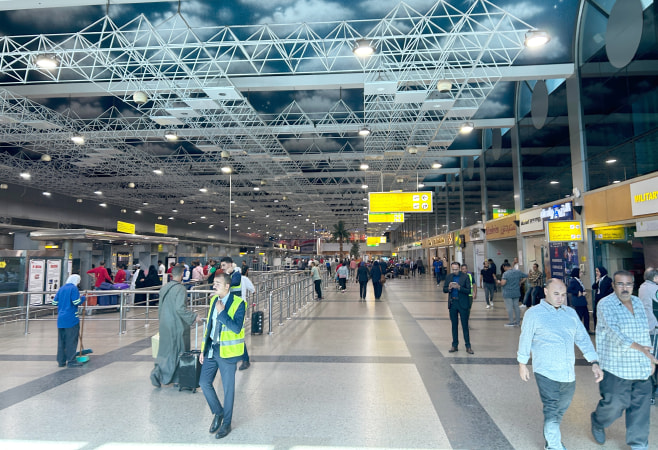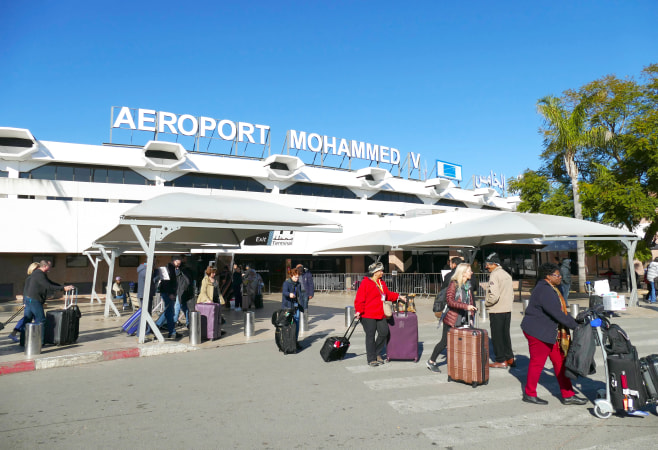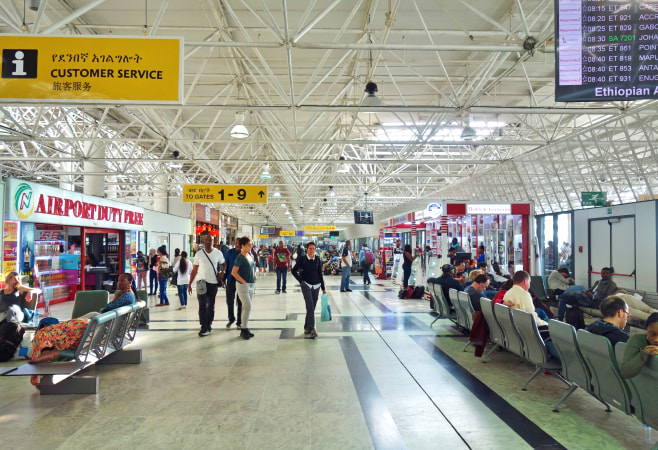Top African Airports Every Traveler Should Know
Africa is a continent on the move, and its airports are the engines of this unprecedented transformation. Today's African airports are vibrant, state-of-the-art hubs that mirror the continent's dynamic economic and cultural growth. They are the frontline of a new era, serving as critical gateways for booming tourism, international trade, and Pan-African connectivity.
This article provides a detailed look at African airports—covering their history, growth, major hubs, passenger services, facilities, and future developments.
Major International African Airports by Region
These are the powerhouses, the continent's super-connectors. They handle millions of passengers annually and are often your first point of entry.
Northern Africa
1. Cairo International Airport (Egypt) – CAI
Cairo International Airport is Egypt’s primary gateway and one of the busiest airports in Northern Africa. Located about 15 km northeast of central Cairo, it serves as the hub for EgyptAir and connects Africa with Europe, Asia, and the Middle East. The airport has three main passenger terminals, each offering duty-free shopping, lounges, and dining options. With its strategic location near the pyramids and the Nile, it is a popular entry point for tourists. Ongoing expansion projects aim to increase capacity beyond 35 million passengers annually, reinforcing Cairo’s role as a leading gateway in Africa.
 Modern facilities at Cairo International Airport (CAI), connecting Egypt to destinations worldwide.
Modern facilities at Cairo International Airport (CAI), connecting Egypt to destinations worldwide.
2. Tunis-Carthage International Airport (Tunisia) – TUN
Named after the historic city of Carthage, this airport is located just 8 km from downtown Tunis. It is Tunisia’s busiest airport, serving both European holidaymakers heading to Mediterranean beaches and regional travelers. Tunis-Carthage has a single terminal with modern amenities, duty-free shops, and VIP services. The airport plays a vital role in Tunisia’s tourism industry, especially for travelers visiting coastal resorts and historical attractions.
3. Mohammed V International Airport (Morocco) – CMN
Situated in Casablanca, Mohammed V International Airport is the largest airport in Morocco and a major hub between Africa and Europe. It is operated by ONDA (Moroccan Airports Authority) and serves as the main base for Royal Air Maroc. The airport features two passenger terminals, a cargo hub, and modern facilities including luxury lounges, shopping outlets, and on-site hotels. Its proximity to Casablanca makes it a convenient gateway for both business and leisure travelers.
 Exterior view of Mohammed V International Airport (CMN) in Casablanca, Morocco’s busiest air hub.
Exterior view of Mohammed V International Airport (CMN) in Casablanca, Morocco’s busiest air hub.
West Africa
4. Kotoka International Airport (Accra, Ghana) – ACC
Kotoka International Airport in Accra is Ghana’s main international gateway and one of the region’s most modern facilities. Following major renovations, Terminal 3 offers world-class passenger services, including automated check-ins, VIP lounges, and expanded baggage handling systems. The airport is strategically positioned as a regional hub for West Africa, serving as a transit point for travelers heading to Europe, the U.S., and other African countries.
5. Félix-Houphouët-Boigny International Airport (Abidjan, Ivory Coast) – ABJ
Located in Port Bouet, Abidjan, this airport is named after Côte d’Ivoire’s first president. It is the busiest airport in French-speaking West Africa and an important hub for Air Côte d’Ivoire. The airport features a modern passenger terminal, duty-free shopping, and VIP services. Its role has grown significantly in recent years, serving as a key connection between West Africa, Europe, and the Middle East.
6. Murtala Muhammed International Airport (Lagos, Nigeria) – LOS
As the busiest airport in West Africa, Murtala Muhammed International Airport is Nigeria’s principal aviation hub. Located in Ikeja, Lagos, it handles millions of passengers annually and is central to Nigeria’s role as Africa’s largest economy. The airport consists of an international and a domestic terminal, with facilities ranging from duty-free shops to business lounges. Despite facing congestion challenges, recent upgrades are improving passenger experience and safety standards.
 Inside Murtala Muhammed International Airport (LOS)
Inside Murtala Muhammed International Airport (LOS)
East Africa
7. Jomo Kenyatta International Airport (Nairobi, Kenya) – NBO
Jomo Kenyatta International Airport is East Africa’s busiest airport and a vital hub for both business and tourism. Located 15 km southeast of Nairobi’s city center, it serves as the headquarters of Kenya Airways. The airport has multiple terminals, including specialized facilities for domestic flights, international departures, and cargo handling. Travelers benefit from lounges, dining areas, and duty-free outlets. It is especially important for safari tourism, connecting travelers to Kenya’s national parks.
8. Addis Ababa Bole International Airport (Ethiopia) – ADD
Bole International Airport is one of Africa’s fastest-growing aviation hubs. Situated in Addis Ababa, it is the central base of Ethiopian Airlines, Africa’s largest and most awarded carrier. Following a major expansion, Bole International Airport now has a designed capacity exceeding 20 million passengers per year. Facilities include multiple runways, a modern terminal, business lounges, and hotels nearby. Its strategic location makes it a preferred transit point for long-haul flights between Africa, Europe, Asia, and the Americas.
 Interior of Addis Ababa Bole International Airport (ADD) with duty-free shops and passenger services.
Interior of Addis Ababa Bole International Airport (ADD) with duty-free shops and passenger services.
Southern Africa
9. O.R. Tambo International Airport (Johannesburg, South Africa) – JNB
O.R. Tambo International Airport is one of the busiest and most important aviation hubs in Africa, serving as South Africa’s premier gateway for international travel. Located in Johannesburg, it handles more than 20 million passengers per year. The airport has six terminals, extensive cargo facilities, and is the main hub for South African Airways. Passengers enjoy a wide range of services, including luxury lounges, international restaurants, duty-free shopping, and on-site hotels. Its world-class infrastructure has positioned it as the continent’s leading gateway.
10. Cape Town International Airport (South Africa) – CPT
Cape Town International Airport is South Africa’s second-busiest airport and a major destination for international tourists heading to the Cape region. Known for its efficiency and customer service, the airport has won multiple awards for best regional airport in Africa. Its facilities include modern passenger terminals, shopping centers, car rentals, and excellent transport links to Cape Town city center. It plays a crucial role in tourism, especially for travelers visiting Table Mountain, the Cape Winelands, and the Cape of Good Hope.
11. Kenneth Kaunda International Airport (Lusaka, Zambia) – LUN
Kenneth Kaunda International Airport, located in Lusaka, is Zambia’s largest airport and a growing hub in Southern Africa. Recently expanded with a new international terminal, the airport is now equipped to handle up to several million passengers per year, marking a major improvement in Zambia’s aviation capacity. The airport provides improved passenger facilities, modern lounges, duty-free shopping, and enhanced baggage handling systems. It serves as a gateway for tourists heading to Zambia’s natural wonders such as Victoria Falls and South Luangwa National Park.
Regional and Domestic Airports in Africa
Beyond the large international hubs, Africa has hundreds of smaller airports. These domestic airports are vital for regional connectivity, especially in countries with limited road networks. Examples include Entebbe International Airport (Uganda), Kilimanjaro International Airport (Tanzania), and Banjul International Airport (The Gambia).
Passenger Experience at African Airports
Security and Customs
Security is a top priority. While many major airports offer modern security systems, others are still improving their facilities. Travelers are advised to allow extra time for customs, immigration, and security procedures, especially during peak hours.
Duty-Free Shopping and Dining
From luxury goods in Johannesburg to traditional crafts in Marrakech, African airports offer diverse shopping options. Dining has also improved, with international brands alongside local cuisines.
Lounges and Business Facilities
Business travelers can access comfortable lounges, especially in major hubs like Addis Ababa and Nairobi.
Wi-Fi and Connectivity
Wi-Fi availability varies. Some airports provide free access, while others require paid services.
Tips for Travelers Using African Airports
Before You Go: The Pre-Flight Checklist
Visa: This is the number one rule. Research visa requirements exhaustively. Some countries offer e-Visas (e.g., Kenya, Ethiopia), some require visas on arrival (check eligibility), and some must be obtained at an embassy in advance.
Health Requirements: Check for mandatory vaccinations (Yellow Fever is a common requirement for entry into many African nations). Carry your International Certificate of Vaccination (Yellow Card).
Cash: While credit cards are widely accepted in major hubs, always have a supply of US Dollars (USD) or Euros (EUR) in small denominations. They are useful for visas on arrival, unexpected fees, or smaller vendors. Local currency from an ATM inside the airport is best for immediate expenses like taxis.
Departure Early Bird Rule: For international flights from major African airports, arriving at least 3 hours before departure is strongly recommended, as security and check-in procedures can take longer than in some other regions. Security and check-in can be slower than you’re used to, and you’ll want time to navigate any unexpected hurdles.
The Layover Lowdown
Lounge Life: If you have a long layover, invest in lounge access (either through your ticket class, frequent flyer status, or a paid pass). It provides guaranteed WiFi, comfortable seating, refreshments, and power outlets—a sanctuary from the main terminal buzz.
Explore with Caution: Some airports (like ADD or JNB) offer transit tours. If you venture out on your own, ensure you have a valid visa, plenty of time (6+ hours), and a secure plan for storing your luggage.
Frequently Asked Questions (FAQs)
How many international airports are there in Africa?Africa is home to dozens of major international airports and hundreds of regional and domestic terminals that connect the continent’s vast geography.
Which is the busiest airport in Africa?
O.R. Tambo International Airport in Johannesburg, South Africa, is the busiest.
Are African airports safe?
Most of Africa’s major airports adhere to international aviation safety standards, though facilities and efficiency may vary from country to country. Travelers should remain cautious and follow local guidelines.
Can I buy a SIM card at African airports?
Yes, many airports offer SIM card kiosks, particularly in major hubs like Nairobi, Addis Ababa, and Johannesburg.
Which African airport is best for connecting flights?
Bole International Airport (Addis Ababa) and Jomo Kenyatta International Airport (Nairobi) are among the top connection hubs in Africa, alongside Casablanca, Accra, and Johannesburg.
Related Articles
- Ivory Coast Birdwatching: Where Are Best Spots & Species
- Top Kitesurfing Spots in Ivory Coast: Where and When
- Ivory Coast Visa and Travel Advisory Updates for Tourists
- Ivory Coast Desserts: Must-Try Dishes for Travelers
- Visa-Free Travel to the Ivory Coast - Things to Know
- Top Outdoor Activities to Experience in the Ivory Coast
- Top Must-Do Activities in the Man Region You Can’t Miss
- Best eSIM for Ivory Coast Travel: Everything You Need to Know
- Hiking Mount Nimba: Trails, Wildlife, and Conservation Info
HOW CAN WE HELP?
APPLY WITH CONFIDENCE
|











